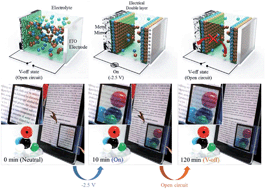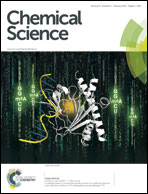Switchable silver mirrors with long memory effects†
Abstract
An electrochemically stable and bistable switchable mirror was achieved for the first time by introducing (1) a thiol-modified indium tin oxide (ITO) electrode for the stabilization of the metallic film and (2) ionic liquids as an anion-blocking layer, to achieve a long memory effect. The growth of the metallic film was denser and faster at the thiol-modified ITO electrode than at a bare ITO electrode. The electrochemical stability of the metallic film on the thiol-modified ITO was enhanced, maintaining the metallic state without rupture. In the voltage-off state, the metal film maintained bistability for a long period (>2 h) when ionic liquids were introduced as electrolytes for the switchable mirror. The electrical double layer in the highly viscous ionic liquid electrolyte seemed to effectively form a barrier to the bromide ions, to protect the metal thin film from them when in the voltage-off state.


 Please wait while we load your content...
Please wait while we load your content...